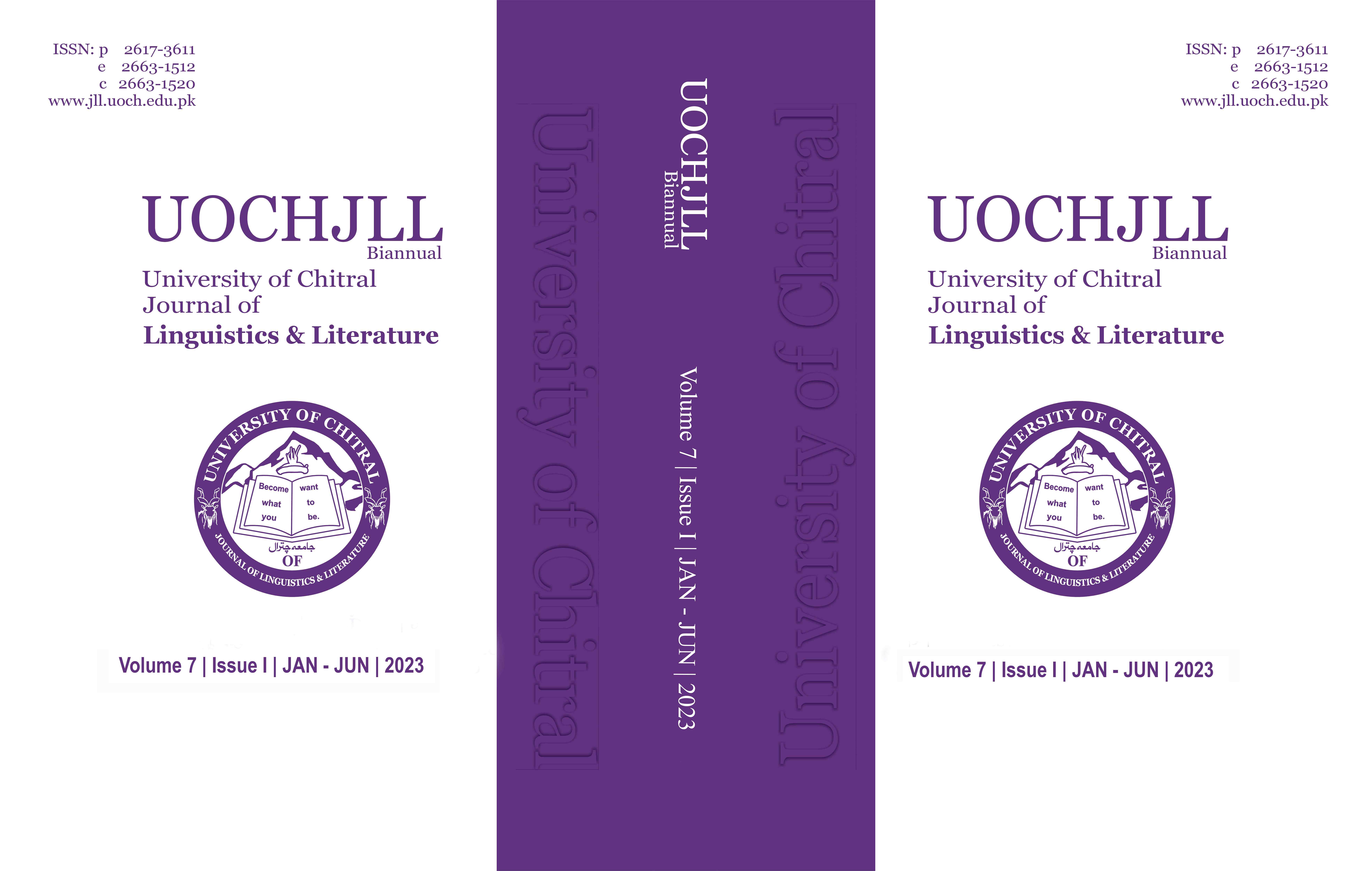Exploring the Influence of Ethnocentrism on Intercultural Communicative Competence: A Quantitative Study on University Teachers
Keywords:
ethnocentrism, diverse cultures, intercultural communicationAbstract
The study was undertaken to check the influence of higher degrees of ethnocentrism on intercultural communicative competence. The sample comprised teachers from two universities in the public sector located in Islamabad. They were given a survey questionnaire followed by the Generalized Ethnocentrism (GENE) scale used to measure their degrees of ethnocentric tendencies. The Three Factor Model of Social Identity and the Model of Intercultural Communicative Competence served as the frameworks of the study. The data were interpreted using regression analysis carried out via SPSS 2.0. All the constructs of ethnocentrism, excluding critical cultural awareness, were discovered to reflect a negative impact on intercultural communicative competence which suggests that the higher degrees of ethnocentrism are detrimental to the peaceful and progressive environment of the workplace where employees from multiple cultures and nationalities serve together. The present study has significance for employees working with colleagues of multiple nationalities. As they meet people from diverse cultures, therefore, they need to mitigate ethnocentric thoughts and feelings related to other cultures and acquire the intercultural communicative competence required for effective intercultural communication. In addition, it is also significant for teachers and students who teach or study with international students.
References
Adorno, T. W., Frenkel-Brunswik, E., Levinson, D. & Sanford, R. N. (1950). The Authoritarian Personality. New York: Harper & Row.
Byram, M. (1997). Teaching and assessing intercultural communicative competence. Clevedon, United Kingdom: Multilingual Matters.
Byram, M. (2009). Intercultural competence in foreign languages: The intercultural speaker and the pedagogy of foreign language education. In D.K. Deardorff (Ed.). The Sage Handbook of Intercultural Competence (pp.321-332). California: Sage Publications.
Cameron, J.E. (2004). A three-factor model of social identity. Self and Identity, 3(3), 239-262.
Deardorff, Darla K. 2006. Identification and assessment of intercultural competence as a student outcome of internationalization. Journal of Studies in International Education 10(3), 241-266.
Dong, Y. (2018). Ethnocentrism and intercultural communication apprehension among Chinese students (master’s thesis, Bryant University, Smithfield, Rhode Island, United States). Retrieved from digitalcommons.bryant.edu/cgi/viewcontent.cgi?article=1002&context=macomm
Ethnocentrism Scale. Journal of Intercultural Communication Research, 31(4), 201-215.
Gudykunst, W.B., & Nishida, T. (2001). Anxiety, uncertainty, and perceived effectiveness of communication across relationships and cultures. International Journal of Intercultural Relations, 25(1), 55-71.
Hello, E., Scheepers, P., & Sleegers, P. (2006). Why the more educated are less inclined to keep ethnic distance: An empirical test of four explanations. Ethnic and Racial Studies, 29(5), 959-985.
Houghton, S. (2009). The role of intercultural communicative competence in the development of World Englishes and lingua franca. The Southeast Asian Journal of English Language Studies, 15(1), 69-95.
Ijzendoorn, M.H. (1989). Moral judgment, authoritarianism and ethnocentrism. The Journal of Social Psychology 129(1), 37-45.
Learning Outcomes in Ho Chi Minh City (pp. 27-42). Ho Chi Minh City: Publishing House of Economics.
Lin, Y., & Rancer, A.S. (2003). Ethnocentrism, intercultural communication apprehension, intercultural willingness-to-communicate, and intentions to participate in an intercultural dialogue program: Testing a proposed model. Communication Research Reports, 20(1), 62-72.
McCroskey, J.C. (1970). Measures of communication-bound anxiety. Speech Monographs 37(4), 269-277.
Nameni, A. (2020): Research into Ethnocentrism and Intercultural Willingness to Communicate of Iraqi and Iranian Medical Students in Iran. Journal of Intercultural Communication Research, 49 (1), 61-85.
Neuliep, J. W. (2002). Assessing the reliability and validity of the Generalized
Neuliep, J. W., & McCroskey, J. C. (1997). The development of intercultural and interethnic communication apprehension scales. Communication Research Reports, 14(2), 145-156.
Neuliep, J. W., & McCroskey, J.C. (2013). Ethnocentrism scale. Retrieved from https://www.midss.org/sites/default/files/ethnocentrism_scale.pdf
Neuliep, J. W., & Spten-Hansen, K. (2013). The influence of ethnocentrism on social perceptions of nonnative accents. Language and Communication, 33 (3), 167-176.
Neuliep, J. W., Chaudoir, M., & McCroskey, J.C. (2001). A cross-cultural comparison of ethnocentrism among Japanese and United States college students. Communication Research Reports, 18(2), 137-146.
Neuliep, J.W. (2017). Ethnocentrism and intercultural communication. In L. Chen (Ed.). Intercultural communication (Chapter 15, pp. 331-347). Berlin/Boston: Walter de Gruyter Inc.
Peng, F.C.C. (1974). Communicative distance. Language Science, 31(1), 32-38.
Romanowski, P. (2017). Intercultural communicative competence in English language teaching in Polish state collleges. UK: Cambridge Scholars Publishing.
Sumner, W. G. (1940). Folkways: A study of the sociological importance of usages, manners, customs, mores and morals. New York, NY: The New American Library.
Tajfel, H. (1974). Social identity and intergroup behaviour. Social Science Information 13(2), 65-93.
Tajfel, H., Turner, J.C. (1979). An integrative theory of intergroup conflict. In W.G. Austin, & S. Worchel (Eds.). The Social Psychology of Intergroup Relations (pp. 33-47). Monterey CA: Brooks-Cole.
Taylor, D M., & Jaggi, V. (1974). Ethnocentrism and causal attribution in a South Indian context. Journal of Cross-Cultural Psychology, 5(2), 162–171.
Thatcher, B. (2004). Rhetorics and communication media across cultures. Journal of English for Academic Purposes, 3(4), 305-320.
Tran, T. Q., & Seepho, S. (2016). An Intercultural Communicative Competence Model for EFL Learners. In the 4th TESOL Conference Proceedings 2016: Teaching Methodologies and
Downloads
Published
Issue
Section
License
Copyright (c) 2023 Sehrish Manzoor, Jamil Asghar Jami (Author)

This work is licensed under a Creative Commons Attribution 4.0 International License.
You are free to:
- Share — copy and redistribute the material in any medium or format for any purpose, even commercially.
- Adapt — remix, transform, and build upon the material for any purpose, even commercially.
- The licensor cannot revoke these freedoms as long as you follow the license terms.





